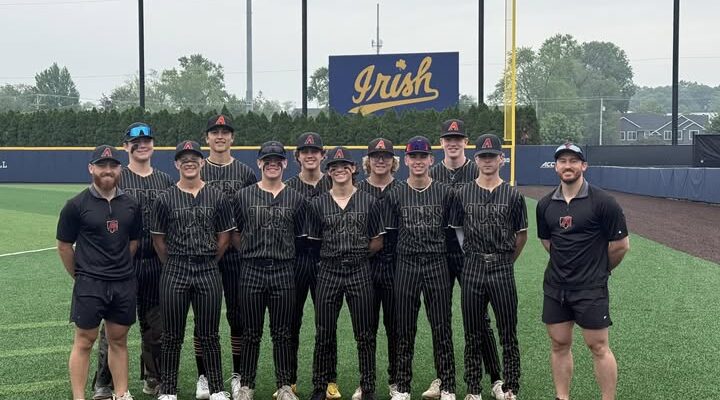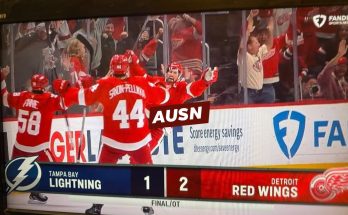As the sun broke the horizon over South Bend, Indiana, the golden dome of Notre Dame shimmered in the early light. The shadows of morning stretched long over the meticulously maintained turf of one of college football’s most sacred cathedrals—Fighting Irish Stadium. But this morning, the echoes weren’t of college greats or Heisman hopefuls. They were of youth—16U athletes from across the region—stepping onto the field not just to compete, but to carve the first etchings of their own football legacy.
This was not an ordinary youth football event. It was a showcase, a proving ground, and, for many, a dream realized. To walk through the same tunnel that legends like Joe Montana, Tim Brown, and Manti Te’o once did; to stand on the field where generations of football history have unfolded—it was more than a game. It was an awakening. A dawn of greatness.
Teams began arriving before sunrise. Charter buses pulled up in quiet procession outside the stadium gates. Coaches gave last-minute instructions under parking lot lamps, and players pulled jerseys over pads with nervous energy pulsing through their veins. As the first rays of light illuminated the stands, parents and fans began filtering in, coffee in hand and excitement buzzing.
Inside, the stadium was silent but expectant. The scoreboard blinked to life. Field staff completed final checks. Somewhere in the air, you could feel it: something special was about to happen.
As the first team jogged through the tunnel and onto the field, there was a collective pause—like time holding its breath. Helmets gleamed under the floodlights still lit from pre-dawn darkness. Cleats tapped on turf. Mouthguards were clenched. For many players, this was the largest stage they’d ever set foot on. And for a few, it wouldn’t be their last.
Sixteen teams. Multiple states. Countless dreams. Every team had a different story, but all were unified by a single purpose: compete at their highest level, under the watchful eyes of coaches, scouts, and the shadow of tradition.
The Games Begin
The tournament format was fast-paced: shortened games with modified clock rules to fit the morning schedule, yet long enough to showcase grit, skill, and resilience. Fields were divided into zones for simultaneous play, but the center spotlight—the full 100-yard field—was reserved for key matchups, highlight reels, and championship aspirations.
The early matchups were electric. One featured a Midwest powerhouse—the Chicago Spartans—against the hard-nosed, disciplined Michigan Hawks. From the first snap, it was clear these boys weren’t just here to enjoy the view; they came to win. Quarterbacks read defenses like seasoned veterans. Linebackers flew to the ball. Wide receivers ran crisp routes, toe-tapping sideline catches that drew roars from the stands.
A 14-year-old quarterback from the Atlanta Storm, barely taller than 5’9”, threw darts across the field, evading pressure with footwork that would make a college scout take notice. On the other side of the field, a defensive end from Cleveland—6’3”, 215 pounds and built like a future All-American—crashed the line with force, disrupting plays and commanding attention.
A Breeding Ground for Greatness
There were no illusions about what this day meant. Yes, it was about fun and camaraderie. But for the most elite among these players, it was also an audition. Eyes from prep academies, private high schools, and elite club coaches scanned the field with notebooks in hand. Conversations buzzed quietly in the background: “Number 18’s vision is unreal,” “That linebacker has a motor,” “Did you see that backpedal from the corner on Field 2?”
But despite the scouting presence, the pressure didn’t weigh these kids down. It lifted them up. They rose to the occasion. It wasn’t just about highlight plays—it was about doing the small things right: wrapping up on tackles, communicating pre-snap, reading defenses, and showing leadership when their teams fell behind.
Coaches paced the sidelines not yelling, but teaching. This was a learning environment, not a win-at-all-costs warzone. And the players listened. Adjustments were made. Mistakes were corrected. Growth was visible in real time.
Parents, Dreams, and Tears
In the stands, parents clutched phones and camcorders, capturing every snap. For many, this was the culmination of years of early mornings, long drives to tournaments, and sacrifices both financial and personal. The pride was palpable. One mother wiped tears as her son scored a touchdown and pointed to the sky in celebration. A father high-fived his son after a hard-fought loss, saying, “That’s how you play with heart.”
The community built around youth football was fully alive in that stadium. Strangers became teammates in the bleachers. Families shared snacks and stories. It wasn’t uncommon to hear someone say, “I remember when he started playing flag at six.”
The Turning Point
As the morning wore on, the stakes grew higher. Semifinal matchups drew more crowd energy, more defensive stands, more breathtaking offensive sequences. A double-overtime thriller between the Dallas Elite and Ohio Thunder ended on a strip sack returned for a score—an explosion of celebration that echoed across the hallowed concrete walls.
What separated the best teams wasn’t just talent—it was chemistry, discipline, and poise. You could see it in how they huddled, how they encouraged each other after missed plays, how they executed under pressure.
The Championship Game
Just before noon, the championship matchup was announced: Atlanta Storm vs. Chicago Spartans. Two teams who had dominated the morning, each with their own flair—Atlanta with speed and finesse, Chicago with raw physicality and discipline.
The crowd swelled. The teams lined up under the blazing sun, and the stadium took on a feeling that felt eerily close to a fall Saturday in October. The band wasn’t playing, but the energy was there.
The game was a battle. Atlanta’s quarterback opened with a 60-yard bomb that brought the crowd to its feet. Chicago answered with a punishing 12-play drive, pounding the ball and eating clock. The game swung like a pendulum—one side giving, the other answering back.
In the final minutes, tied at 14-14, Chicago drove deep into Atlanta territory. On 4th and goal from the 6, the Spartans called a fade to their star receiver—6’2”, with hands like magnets. The pass was perfect. The catch, better. Touchdown.
Atlanta had one last shot. With 30 seconds and no timeouts, they marched to midfield. A final Hail Mary was launched high into the South Bend sky—hovering, spinning, pulling eyes upward. For a moment, everything stood still.
Then—contact. The ball fell. Incomplete. The Spartans erupted.
More Than a Trophy
The Spartans lifted their trophy at midfield, posing for pictures, gold medals around their necks. But as the fans filtered out and the field crews began cleanup, a deeper truth settled in.
This morning wasn’t just about wins and losses. It was about experience. Confidence. Brotherhood. Legacy. Every player left the field with something—whether it was a moment of glory, a lesson learned, or a memory forged forever.
For some, this was just the beginning of a journey that might lead to Friday night lights, scholarship offers, and maybe even a shot at Saturdays in stadiums like this one. For others, it was simply a day to say, “I played on that field. I gave it my all. I belonged.”
Notre Dame’s stadium has seen national championships, miracle comebacks, and college football’s greatest names. But on this morning, it bore witness to something more humble, yet equally inspiring: the rising tide of youth, passion, and hope. The echoes didn’t just speak of past greatness—they whispered of greatness yet to come.
And so, as the final player jogged off the field and the sun climbed higher in the Indiana sky, one truth remained:
This wasn’t just a football tournament.
It was the dawn of greatness.



